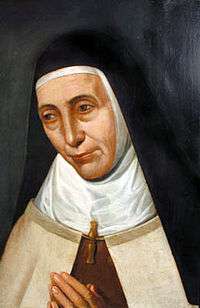Anne of Saint Bartholomew
| Blessed Anne of St. Bartholomew, O.C.D. | |
|---|---|
|
Anonymous portrait (1600) | |
| Virgin and nun | |
| Born |
1 October 1550 Almendral de la Cañada, Old Castile, Crown of Castile |
| Died |
7 June 1626 Antwerp, County of Flanders, Spanish Netherlands |
| Venerated in |
Roman Catholic Church (Discalced Carmelites) |
| Beatified | 1917 by Pope Benedict XV |
| Feast | June 7 |
Anne of St. Bartholomew, O.C.D. (Spanish: Ana de San Bartolomé) (Almendral de la Cañada, Old Castile, 1 October 1550 – Antwerp, 7 June 1626), was a Spanish Discalced Carmelite nun, and companion to St. Teresa of Avila. She led the establishment of monasteries of the new Order in France and the Lowlands. She has been beatified by the Catholic Church.
Life
Born in the small village of Almendral of old Castile (Spanish: Castilla la Vieja), on the 1st of October, in the year 1550, on the Feast Day of Saint Remy, Ana García Mancanas was the seventh child of Maria Mancanas and Ferdinand García. The very day of her birth, her parents of strong faith, brought her to the Church to be baptized. Together with her three brothers and three sisters, she was raised very close to God by her pious parents. Everyday, their entire family assisted in Holy Mass and recited the Holy Rosary in the private oratory. Her father had a priest teach the children Christian Doctrine daily. Her mother in particular, opened their home to the poor and adopted orphans to raise as her own. With the virtuous example of her father and her mother, Ana's heart grew to love and want to serve God. At the tender age of ten, both her parents passed, and it was a time in her life that she described as being flung into her "deepest affliction."[1] When she was of the proper age, her older siblings wanted her to marry, but in her heart she only attended to her desire to be a religious. Her older brothers tried to test her will by giving her the very difficult task of sharing the work of the day laborers at the fields, hoping that she would renounce her calling. The brothers felt that she was too tenderhearted to live in the austerity of a monastic life, that she would join only to leave and eventually, burden the family with dishonor. Ana experienced many holy visions and apparitions that made her unwilling to give up. However, on one occasion, she had a frightful apparition of a giant demon that scared her to the point of illness. Concerned for her well-being, her relatives took her to a hermitage dedicated to St. Bartholomew to make a novena. When Ana arrived outside the hermitage, she was suddenly seized with paralysis. Ana's relatives carried her in and shortly after entering, she found herself completely cured.
Ana later entered the monastery as lay sister, the first admitted by the foundress, and made her religious vows on 15 August 1572. For the next ten years she filled the post of infirmarian. When St. Teresa broke her left arm on Christmas Day 1577, Ana became her almost inseparable companion, caregiver and secretary, in whose arms Teresa died at Alba de Tormes in 1582.
Ana afterwards returned to Avila, took part in the foundation of a convent at Ocana (1595), and was one of the seven nuns selected for the introduction of the order into France (October, 1604). The French superiors, desirous of sending her as prioress to Pontoise, obliged her to pass from the state of lay sister to that of choir nun. So unusual a step met with the disapproval of her companions, but, as St. Teresa had foretold it many years previously, Ana offered no resistance. She had also been forewarned that the same step would cause her great sufferings.
Ana's priorship at Pontoise (January to September, 1605), Paris (October, 1605, to April, 1608), Tours May, 1608, to 1611) brought her heavy trials, not the least of which were differences with her superiors. At the expiration of her last term of office she returned to Paris, but warned by a vision, she proceeded to the County of Flanders (October, 1611), where she founded and became prioress of a monastery in Antwerp (27 October 1612), which she governed to the end of her life. Twice she was instrumental in delivering the town from the hands of Protestant forces.
In 1735, Anne of St. Bartholomew was declared Venerable. She was beatified in 1917.
Works
Anne's writings include a number of letters still preserved, an autobiography now at Antwerp, edited by Marie Dominique Bouix (Paris, 1869–72), and several treatises on spiritual matters, which appeared at Paris in 1646.[2] An extensive bibliography is found on the website of The Friends of Sr Ana.[3]
References
- ↑ https://archive.org/stream/AutobiographyBlMotherAnneOfStBartholomew#page/n39/mode/2up
- ↑ Urkiza, Julen (2007). Beata Ana de San Bartolomé. Obras Completas.. Madrid: Monte Carmelo. ISBN 978-84-7239-505-3.
- ↑ http://www.anadesanbartolome.org/bibliografia.html
- Attribution
 This article incorporates text from a publication now in the public domain: Herbermann, Charles, ed. (1913). "Anne García". Catholic Encyclopedia. New York: Robert Appleton. The entry cites
This article incorporates text from a publication now in the public domain: Herbermann, Charles, ed. (1913). "Anne García". Catholic Encyclopedia. New York: Robert Appleton. The entry cites
- ENRIQUEZ, Historia de la Vida etc. (Brussels, 1632, Fr. tr. at Paris, 1633);
- La Vie et les instructions de la Ven. Mère Anne de S. Barthelemy, par un solitaire de Montaigne (Brussels, 1708; new ed., Paris, 1895).
| Wikimedia Commons has media related to Anne of Saint Bartholomew. |
